Isopods 101 – Woodlice
Isopods 101: Welcome To The Wonderful World Of Woodlice
Woodlice (Isopods, or animals of the Order Isopoda) are among the most familiar of animals.
They have featured prominently throughout history, in recipes (Holt 1885, included a recipe for woodlouse sauce), in the poetry of Sir John Betjeman, the novels of Jean Paul Sartre, the paintings of Paul Klee – and have even provided the inspiration for a sermon.
In the past, wood lice were often carried in a small pouch attached to a cord around the neck. These were swallowed as a cure for stomach aches and other minor ailments.
It is possible that the calcium carbonate in their exoskeletons is able to neutralise stomach acids – although I confess I have not had the courage to test this theory!
The beneficial effects of woodlice far outweigh any damage that they do. However, woodlice have an ill-deserved reputation as pests; mainly because they wander into houses at night (usually to escape supersaturation with water during wet weather).
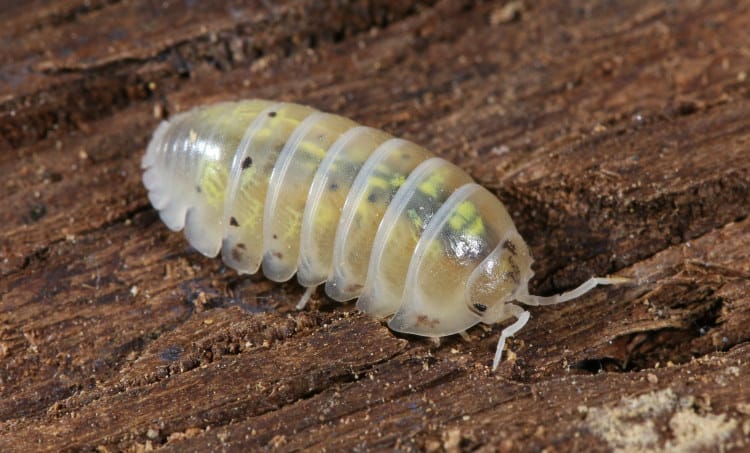
Wood lice may travel considerable distances during these nocturnal rambles. I have found some isopod specimens trapped inside a light shade of a bedroom, on the first floor of a building.
In the garden, woodlice rarely attack living plants, preferring to eat vegetation which has begun to decompose. In glasshouses, woodlice may occasionally nibble seedlings but they rarely do any significant economic damage.
In the litter layer of deciduous woods, and on compost heaps, wood lice perform a vital role. They chew dead plants into small fragments and deposit these as faecal pellets, which decompose rapidly.
Isopods may also graze fungal hyphae from leaves (Gunnarson, 1987) or their own faecal pellets (Hassall and Rushton)) and this may form an important source of nutrients, when the only food available is of poor quality. Deposition of faecal pellets, containing fungal spores in deep moist leaf litter by woodlice, may be important in stimulating decomposition in woodlands.
Thus, the feeding activities of woodlice speed up the decomposition process and help to return essential nutrients to the soil.
All British woodlice are predominantly vegetarian. However, there are some foreign species that have a more varied diet. In New Zealand, the main food of the sand beach woodlouse Scyphax ornatus is drowned honeybees. In the US, woodlice are used by museum workers to clean the flesh from delicate vertebrate skeletons.
Order Isopoda: Evolution, Distribution and Ecology
Woodlice are members of the class Crustacea, which also includes crabs, shrimps and lobsters. Most crustaceans are aquatic. Only two orders contain species which are able to live their whole life cycle away from water.
These are the Isopoda (which includes the woodlice) and the Amphipoda.
In the British Isles, there is only one species of terrestrial Amphipod, Arcitalitrus dorrieni, that can live permanently on land. This was introduced to Britain from Australia – and is now quite widespread in Cornwall and South Devon (Harding and Sutton, 1988). It has been discovered recently in several other areas of Britain, including Kew Gardens.
The order Isopoda contains more than 10,000 species of Isopod worldwide; most of which are marine. About 3,500 species of wood lice (Suborder Oniscidea) have been described, but there are probably at least as many waiting to be discovered – especially in tropical rain forests.
Isopods evolved in the sea and are thought to have made the transition to land via the seashore. Species such as the common sea slater, Ligia oceanica, are still restricted to the coast.
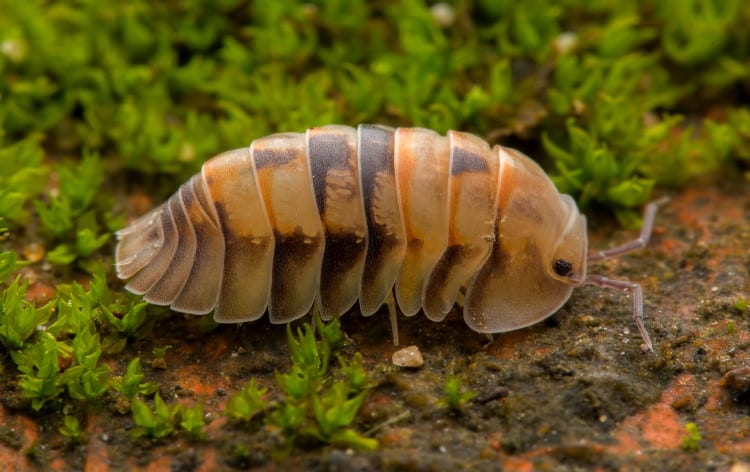
Successive Isopoda species became increasingly resistant to the rigours of a terrestrial existence – and probably colonised the land via moist leaf litter of pteridophytes (horsetails and ferns) during the Carboniferous (Piearce, 1989).
Two key features likely helped ‘pre-adapted’ marine isopods to colonise the land.
First, the dorso-ventral flattening of the body gave them an extremely stable ‘squat’ posture when walking. Second, retention of the young in a fluid-filled brood pouch protected them from drying out in the first few weeks after hatching from the egg.
All isopods have seven pairs of legs, which are usually of similar structure (hence the name iso-pod from the Greek isos meaning ‘equal’ and podes meaning feet).
Traditionally, woodlouse have been regarded as poorly adapted to life on land. However, research conducted in recent years has shown that woodlice have evolved several sophisticated physiological and behavioural mechanisms to control water loss.
These include the modification of the pleopods, to form lungs; and a capillary conducting system which allows nitrogenous waste to be excreted as ammonia gas (without significant loss of water – Hoese, 1984).
Indeed, the Dutch word for woodlice ‘pissebed’ is probably derived from the smell of urine that large aggregations of woodlice give off.
Wood lice have colonised some of the most extreme environments on earth, including deserts in Israel and North Africa – and hypersaline pools in Australia via fully terrestrial forms.
The desert species Hemilepistus reaumuri occurs in burrows at densities of greater than 100 per square metre. This remarkable woodlouse pairs for life and is able to relocate its burrow, using the position of the sun in the sky.
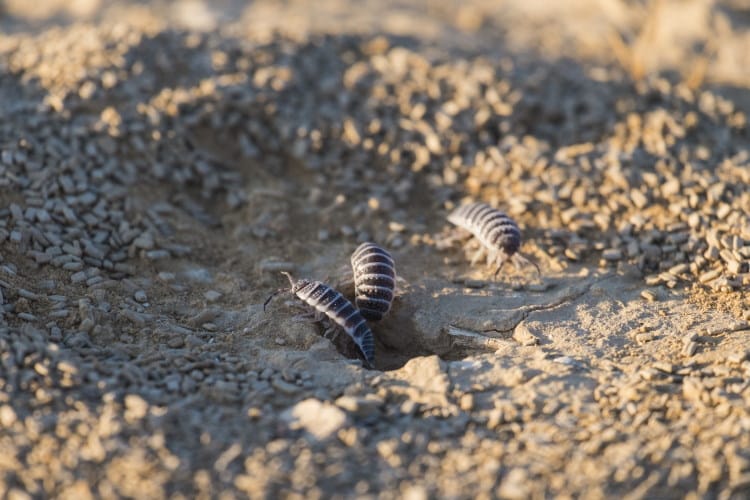
The juveniles help to maintain the burrow. Thus, this species is the nearest we have to true social behaviour (eusociality) in woodlice. Individual Hemilepistus are able to walk several kilometres in a few days, quite a feat in the rigorous desert environment.
The only animals known to prey exclusively on woodlice are spiders of the genus Dysdera. Many other animals will, however, eat them; and toads can be reared to adulthood on a diet that consists entirely of woodlice.
In terms of impact of predation on numbers, centipedes consume about 40% of all woodlice that are eaten. The great majority of woodlice that fall victim to predators are immature (Sunderland and Sutton, 1980).
All woodlouse have six pairs of legs when released from the brood pouch of the female. At this stage, they are called ‘mancas’. After the first moult, which occurs within 24 hours of release, the 7th leg bearing segment appears; and after another moult, they gain their full complement of seven pairs of legs and are juveniles.
Juveniles moult at regular intervals until they reach sexual maturity, usually within a year, when they become adults. The moulting process continues after maturity (although with less frequency) and involves shedding the exoskeleton in two parts. The posterior part (pleon and pereon segments 5,6 and 7) is shed a few days before the anterior part (head and pereon segments 1,2,3, and 4).
Life Cycle
Few woodlice live for more than two or three years. The life cycles of woodlice are quite variable between species, and different geographical areas.
The common pill woodlouse, Armadillidium vulgare, for example, lives for 4 years in California (where it was introduced at the turn of the century) and females have 3 or 4 broods in a lifetime. At Spurn Head in Yorkshire, however, females of the same species have only 2 broods; whilst at Lakenheath in Suffolk they have only one (Sutton et al., 1984).
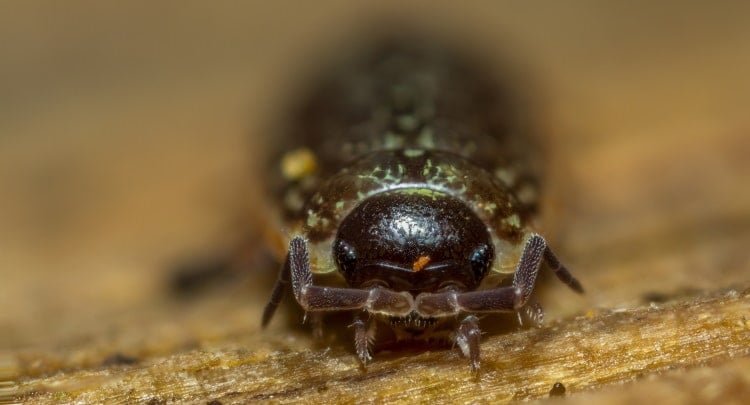
The common striped woodlouse, Philoscia muscorum, on dune grassland exhibits a clear example of ‘year class splitting’. Individuals born in one season differentiate into two forms; one of which grows to maturity in one year, the other in two (Grundy and Sutton, 1989).
Such flexibility is one of the reasons why woodlice are so successful in colonising disturbed environments.
Only 37 species of wood lice are known to breed out of doors in the British Isles (another ten or so have been recorded only in glasshouses). They range from 2 mm to 30 mm in length. Two species, Oniscus asellus and Porcellio scaber, are particularly common around buildings and are ideal animals with which to conduct simple laboratory experiments.
There is even one species, Platyarthrus hoffmannseggi , which is nearly always found associated with ants.
Recent discoveries on parasites; the structure and function of the digestive system; and the accumulation of metal pollutants by woodlice, have shown that there is much that remains to be discovered about the biology and distribution of these fascinating and (dare I say it) endearing creatures.
What Does A Woodlouse Eat?
Philoscia muscorum lives almost entirely on rotting leaves and occupies a similar habitat in both summer and winter. However, other species such as Trichoniscus pusillus (Common Pygmy Woodlouse), which share the leaf litter with it during the winter, change their habitat during the summer and live almost entirely on and in rotting wood.
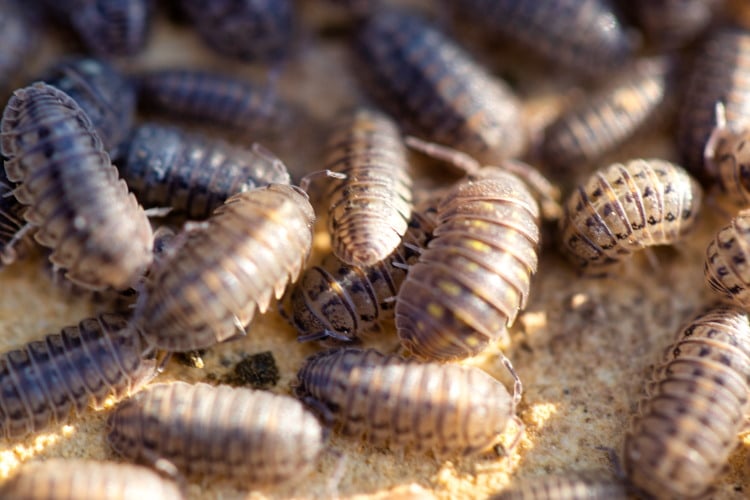
While Porcellio scaber, which lives at the bases of trees during the winter, moves higher up into the trees in summer. Not all Wood lice live in woods or Grasslands; Hemilepistus reaumuri lives in arid areas of North Africa and the Middle East, where it survives in small family groups in holes dug in the ground (these are 5-6 cms wide and can be over 30 cms deep)
Digging is stimulated by high temperatures (over 35 C) so if the bottom of the hole gets too hot, they dig it a bit deeper.
Even stranger than this are Platyarthrus hoffmannseggi (Ant Woodlouse) a blind, eyeless, white woodlice found in Britain and Europe; and Trichoniscus commensalis a pale coloured, but still eyed, species from New Zealand. Both of these live primarily in ant nests, feeding on ant droppings and fungi.
Mating
Mating in Isopods occurs at night, and is therefore hard to see.
The male climbs onto a receptive female, licks her head and drums on her back with his legs for about five minutes.
He then shifts to a diagonal position on the female’s back and passes sperm to her left side genital opening from his right hand stylets. He then changes his position to the opposite diagonal – and deposits sperm in her right hand genital opening from his left hand stylet. Sperm transfer takes about 5 minutes for each side.
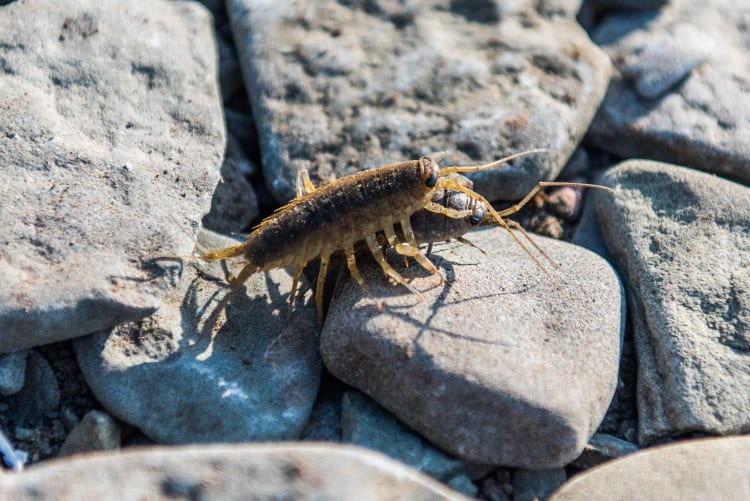
In some species, such as Philoscia muscorum and Armadillidium vulgare, breeding is synchronised within a colony – so that all breed at the same time. Most Isopod species have one brood per year in Britain, though some such as P. muscorum have two in the South.
The exception to this is the small triploid (having three sets of chromosomes) Trichoniscus pusillus, which has two broods all over Britain. The number of eggs produced by a female of any given species increases with an increase in the size of the female; one female Armadillidium vulgare is recorded as having had a brood of 267 young. The eggs take from 3 to 9 weeks to hatch and spend from 3 to 9 nine days in the brood pouch.
Predators and Parasites
Though many spiders find Wood lice distasteful, a few species will eat them, i.e. Tegenaria gigantea and T. domestica. While some species, like Dysdera crocata and D. erythrina have jaws specially developed to deal with Woodlice and live almost entirely on them.
Armadillidium klugii from Dalmatia is a spider mimic and looks like the poisonous Laterodectes mactans, especially when young.
The only parasites of Woodlice in Britain are 7 flies of the family Rhinophorinae. Porcellio scaber is the most heavily parasitised, with 14% of those checked by Dr S.L.Sutton being attacked by 6 of the 7 species; 68% of these were attacked by Parafeburia maculata, 17% by Styloneuria discrepans, 9% by Melanophora roralis, 3.7% by Rhinophora lepida, 1.6% of Frauenfeldia rubricosa and 0.08% by Phyto melanocephala.
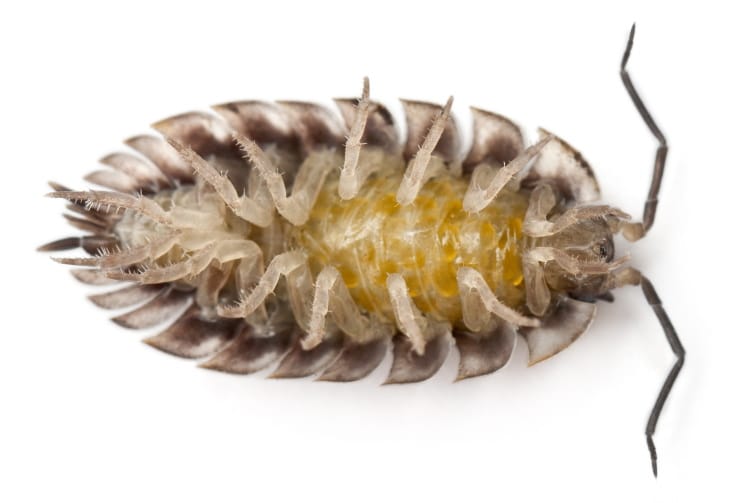
Oniscus asellus is attacked by Parafeburia maculata and Styloneuria discrepans though not as heavily as P. scaber; less than 1% of those checked were parasitised. Armadillidium vulgare is also attacked by Phyto melanocephala while Trachelipus rathkei is attacked by Stevenia atramentaria.
None of the other 7 species of Woodlice he checked had any parasitised individuals at all. Woodlice are also consumed readily by many small mammals such as shrews, which may easily consume over 100 per day if they can find them, as well as by many small birds.
Final Thoughts
Well, I hope this has been an interesting glimpse into the wonderful world of Order Isopoda!
For more information on keeping and breeding your own woodlouse see my page on Woodlice as pets.
Though woodlice are some of my favourite creatures, I have not written this page. Instead I am grateful (and you are fortunate) that Stephen Hopkin, who knows far more about Isopods than ever I will, has allowed me to use his introduction to “A Key to the Woodlice of Britain and Ireland” (Aidgap Key No 204).

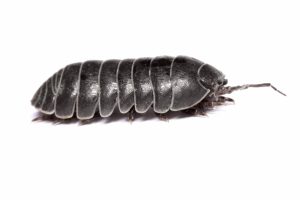
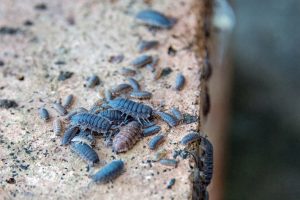
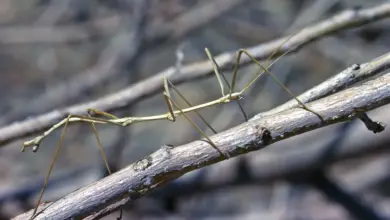
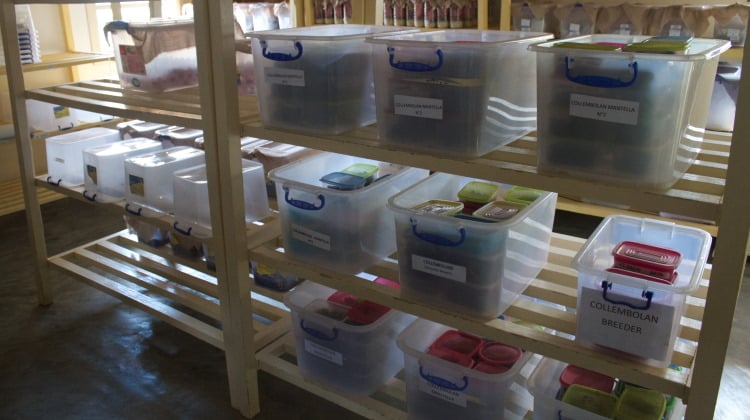
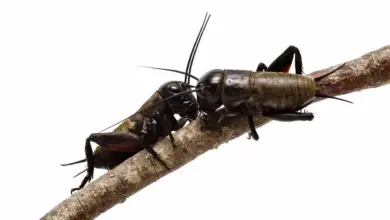
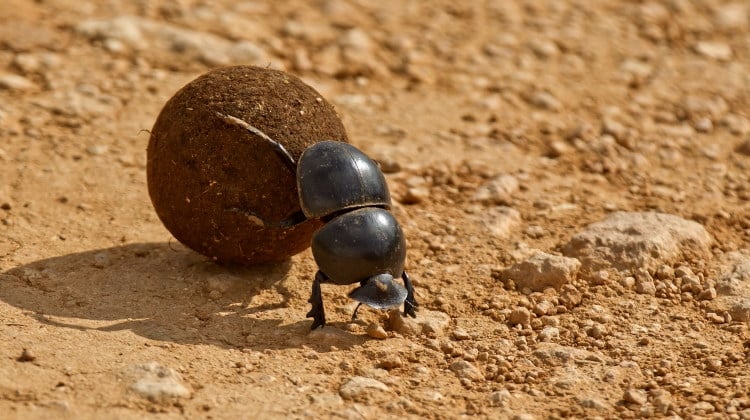
Hello, thank you for this very informative web site. I found a white wood louse in my orchard garden, here in North Yorkshire. Never having seen a white one before, I considered it may be a unique mutation and was delighted to read that it is quite a normal event. I share your enthusiasm for this ubiquitos garden creature which always seems to occur in a family unit with lots of children, at least in my garden, much to the delight of my grandson.